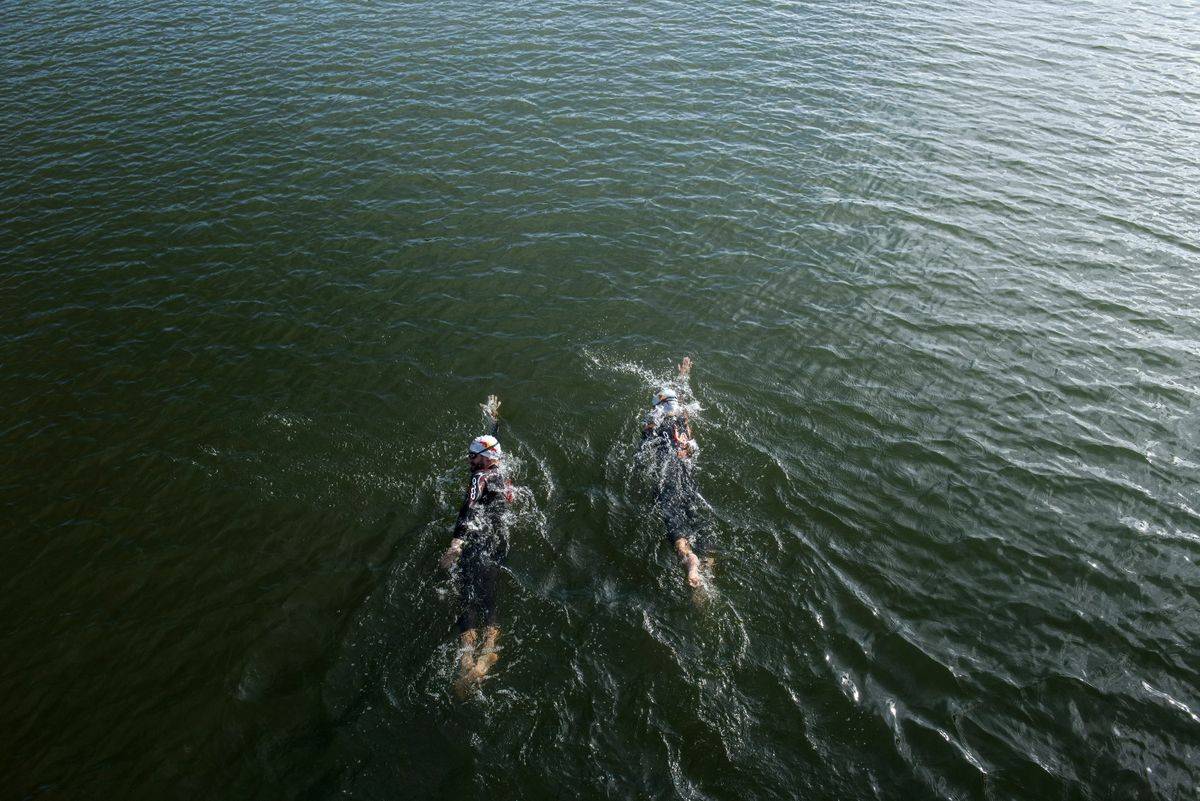Für die ersten Ausflüge ins Freiwasser gilt es sich gut vorzubereiten, denn das Schwimmen in der Halle und im offenen Gewässer zwei paar Schuhe. Das betrifft sowohl Material, als auch das eigene Können und das persönliche Selbstvertrauen. Wir haben die Tipps für den Ausflug ins Freiwasser.
Grundsätzlich gilt: jedes offene Gewässer ist anders. Wassertemperatur, Strömungen, Wellengang, Sicht, Untergrund und Ufer sind wohl die Dinge, die man vorsichtig erkunden oder auch erfragen sollte, bevor man sich motiviert ins Nass stürzt. Stopp! Noch nicht! Es gilt noch einige Dinge am Ufer zu erledigen!
Kälteschutz
Ohne > Neoprenanzug ist an ein richtiges Schwimmtraining im See nicht mehr zu denken. Der Neo schützt vor Auskühlung und ist durch seine Auftriebseigenschaften eine natürliche Schwimmhilfe. Im offenen Gewässer bietet er damit auch zusätzliche Sicherheit, da man mit Neo immer an der Wasseroberfläche gehalten wird und sich auch einfach mal nur "treiben" lassen kann.
Aktuell ist es sogar sinnvoll, auch diejenigen Körperteile vor Kälte zu schützen, die nicht vom Neoprenanzug bedeckt werden. Das betrifft vor allem den Kopf, aber auch Hände und Füße verlieren schnell Temperatur.
Uneingeschränkte Sicht
Trübes Wasser und fehlende Bezugspunkte aus dem gewohnten Schwimmbecken sorgen bei vielen Athleten zunächst für ein gewisses Maß an Unsicherheit im offenen Gewässer. Da wir so stark auf unseren optischen Sinn zur Orientierung angewiesen sind, ist deshalb die uneingeschränkte Sicht ein sehr sensibles Kriterium im Freiwasserschwimmen. Wichtig daher: die Wahl der Schwimmbrille für den richtigen Durchblick. Gerade im Freiwasser sollte die Brille gut und zuverlässig sitzen, kein Wasser einlassen, nicht beschlagen und ein weites Sichtfeld ermöglichen. Die meisten Triathleten setzen hierbei auf die sog. Saugnapfbrillen mit großem Sichtfeld und gebogenen Gläsern. Durch die gebogene Passform und die weichen Dichtungen liegen sie zumeist um die Augenhöhle herum und saugen sich quasi fast von selbst fest. Dadurch werden die Augen einerseits zuverlässig vor Keimen und anderen Fremdkörpern im Wasser geschützt. Andererseits ist damit ein großes Sichtfeld gewährleistet. Zusätzlich bieten die Gläser UV-Protektion und können durch ihre jeweilige Tönung auch grelle Sonneneinstrahlung herausfiltern.
Los geht's
Halt – nicht zu hastig! Besonders bei niedrigen Wassertemperaturen oder vorhergehendem Aufenthalt in der Sonne solltet ihr es lieber ruhig angehen lassen, um den Körper an die Wassertemperatur zu gewöhnen.
Im Wettkampf hat es sich bewährt gründlich einzuschwimmen. Sonst kann es die ersten Meter auch schnell mal zu Atemnot kommen. Falls das passiert oder Ihr in Panik geratet – kein Problem. Ein Paar Züge Brust, tief durchatmen und weiter geht’s. Grundsätzlich gilt auch hier: Übung macht den Meister. Einige kurze Trainingseinheiten im Freiwasser helfen, die Scheu vor dem dunklen Wasser zu überwinden.
Bezugspunkte & Orientierung
Die Orientierung im offenen Gewässer erfolgt anhand von festen Bojen oder Fixpunkten am Ufer. Diese solltet ihr euch bereits vor dem ersten Schritt ins Wasser schon einmal merken. Seid ihr erst im Wasser, ist es deutlich schwerer eine Boje zu erkennen, da euer Kopf jetzt auf Wasserlevel ist.
Ist die Boje vorübergehend nicht mehr sichtbar (z.B. bei Wellengang), kann man diesen vorher ausgesuchten Fixpunkt anschwimmen. Das kann ein hoher Baum, Fahnenmast, Gebäude oder ähnliches sein, dass in Verlängerung zur Boje am Ufer gut auszumachen ist.
Die Orientierung erfolgt durch einen kurzen Blick nach vorne, der in die Kraulbewegung möglichst reibungslos einfließen soll. Es hat sich bewährt alle fünf bis sechs Züge bei der Atembewegung den Kopf etwas zu heben. Auch das kann im Training vorher eingeübt werden. Man beginnt die Übung mit abwechselnd einem Stück Wasserballkraul, gefolgt von normalen Kraulzügen. Langsam baut man die Zuganzahl, die man im Wasserballstil schwimmt ab und hat irgendwann eine kurze Zeitspanne übrig, bei der man sich nach vorne orientieren kann.
3-er Atmung ja oder nein?
Um den inneren Kompass möglichst geradlinig zu halten, hört man immer wieder die Empfehlung: im Freiwasser 3-er Atmung schwimmen. Durch das wechselseitige Atmen soll das Abdriften zu einer Seite verhindert werden. Ob es funktioniert? Probiert es aus. Es gibt hier keine goldene Regel. Auch die 3-er Atmung bietet keine Garantie, um konstant gerade aus zu schwimmen. Die Umstellung von einer 2-er Atmung könnte sich am Anfang sogar als nachteilig erweisen, da durch die geringere Atemfrequenz insgesamt weniger Sauerstoff aufgenommen wird. Sauerstoffmangel in Verbindung mit ungewohntem Schwimmrevier ist keine gute Kombination. Tastet euch also langsam an die vielen Variablen im offenen Gewässer heran. Sicherheit geht immer vor!
Übung macht den Meister
Mit jeder Trainingseinheit im Freiwasser wächst das Vertrauen in die eigenen Fähigkeiten und in euer Material, die Handgriffe beim An- und Ausziehen des Neos gehen Fleisch und Blut über. Für den Einstieg in das Freiwassertraining ist zunächst das konstante Streckenschwimmen die trainingsmethodisch sinnvollste Variante: Gewöhnung an das offene Gewässer, Orientierung, Schwimmen mit Neoprenanzug stehen hier im Vordergrund. Wie lange ihr schwimmt, ist zunächst egal - sicherlich auch abhängig von der Temperatur und eurem Leistungsniveau.
Im nächsten Schritt geht es dann darum, das Training im Freiwasser variabler zu gestalten und spezifische Akzente zu setzen, um das ausgefallene Schwimmtraining im Becken zu kompensieren, aber auch die deutlich höhere Dynamik in einem Wettkampfszenario zu üben. Diese Tipps erhaltet ihr dann in unserem nächsten Beitrag.




















